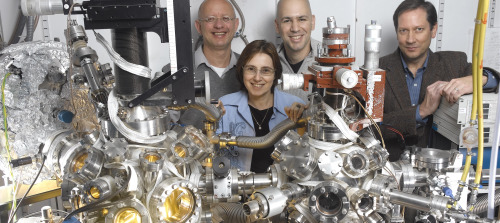Scientists from Israel and the US are working together to determine the durability of Israeli artificial diamonds as coatings for equipment used in space.

When the Beatles wrote the song, Lucy in the Sky with Diamonds four decades ago they may have been alluding to something different, but today the song evokes a new US-Israel endeavor to launch diamonds into space.
The aim is to subject diamonds created artificially in an Israeli lab to real-life space conditions in order to test their durability as potential components of future instruments to be used beyond our planet.
Sent to space on a recent NASA mission, the diamonds were hung outside the International Space Station circling Earth in low orbit, about 215 miles above us in the sky. Researchers plan to examine the damaging effects on the diamonds of atomic oxygen in low orbit, which aggressively attacks carbon-based materials.
Project leader PhD candidate Ze’ev Shpilman from the Technion – Israel Institute of Technology hopes to show that artificial diamonds can be an ideal coating for equipment used in the space environment.
Being the hardest material on earth, the “hardness” of a diamond is the measuring stick by which all other degrees of hardness are measured in science. The material’s resistance to fracturing, and the fact that a diamond can act as a super efficient conductor of heat, make it a flexible and useful material that could be suitable for use in future space equipment, including satellites.
Shpilman tells ISRAEL21c that the artificial diamonds on the NASA mission are expected to be returned to the lab in Israel or the US for analysis in less than a year.
It’s the surface that counts
The unique Israeli contribution to the study, Shpilman points out, is that it was the Technion team in conjunction with scientists at the Soreq Nuclear Research Center in Israel that led researchers to the discovery of the optimal “orientation” of the surface of the artificial diamond coating that can weather the worst in space.
The team, which includes Shpilman’s partners and supervisors Prof. Alon Hoffman and Dr. Joan Adler at the Technion and Dr. Irina Gouzman from Soreq, has discovered which patterns of diamond crystals work best to resist atomic oxygen in space. Down here on earth, atomic oxygen isn’t a worry as the element easily combines with hydrogen creating a relatively stable molecule. In space, it’s a different story. The atomic oxygen seeks to bind with other materials.
“The thing here is not to find new diamonds with a new hardness. Artificial diamonds have been grown in laboratories for the last two or three decades,” says Shpilman. “In my PhD studies I characterize these diamonds grown and study how they interact in the space environment.
“There are many applications: It is the best heat-conducting material – orders of magnitude higher than any other material. And diamonds are light. Because they are made of carbon they are perfect for use in space,” he explains.
“The problem was that there was a lack of knowledge about how diamonds interact in the space environment. We wanted to study this,” he tells ISRAEL21c.
Hoping for a long-lasting material for space applications
The team started in the lab where they simulated the aggressive space environment that contains highly reactive atomic oxygen.
The artificial diamonds grown in the lab are not the nuggets one would set into an engagement ring, but a thin film to be used as a coating. Under the microscope each one looks like mountains of small crystals.
The diamonds are grown in Hoffman’s lab and tested at Soreq and by Prof. Tim K. Minton at Montana State University in the US. Minton, who is collaborating on the project, included the Israeli-made diamond samples in a set that he sent on the NASA mission.
Meanwhile, Shpilman is hoping the space tests will show the results he suspects: That the Israeli-grown diamonds, with their special orientation, can withstand space better than any others. If so, “We’d have a long-lasting material for space applications,” he says, adding that the team’s research was recently published in Applied Physics Letters.
When asked about the availability of samples of his diamonds, Shpilman disappoints, recounting in his defense that even when he married and his wife wanted a “real big diamond,” he couldn’t create one for her in the space lab, but like every other guy had to go to a jewelry store and buy one.











